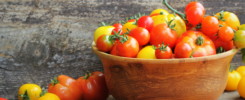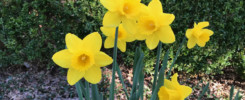Submitted by: Douglas Justice, Associate Director, Horticulture & Collections (UBC Botanical Garden)
Ecological services, aesthetics
There is a lot of accumulated research that tells us that trees are valuable. Trees provide ecological services that include extracting carbon dioxide from the air and replacing that (minus the carbon that is sequestered in plant tissues) with oxygen. Trees filter particulates out of the atmosphere, create shade for people, and habitat and food for birds and wildlife, and their roots help to stabilize soil and reduce erosion. Street trees raise property values, calm traffic, improve our wellbeing, and cool our neighbourhoods. Some trees produce beautiful flowers, attractive bark or spectacular autumn colours, and most trees are attractive and restful to the eye when in leaf. It’s little wonder that people like trees.
In with the new and…
Nowadays, people are used to chucking out what’s considered old. Mobile phones, computers and other technological devices continue to get faster and more powerful, making their older counterparts less valuable, or at least less valued. What about trees? Ancient trees are often humbling to us, and even a hundred-year-old tree can inspire awe, but there’s more to old trees than an impressive stature. The bigger and older a tree, the more value it provides in ecological services. More birds, more carbon sequestered, more clean air and oxygen, but because older tissues introduce diversity (old bark, rotting wood, etc.), there are greater opportunities for a wider variety of organisms. In other words, more different kinds of insects and other invertebrates, but also more different kinds of birds to feast on them and to sing.
So you want to plant a tree
There are lots of choices. Fruit trees can be rewarding (who doesn’t like to eat fresh fruit?), but also challenging for people who aren’t committed to a higher level of management. Consider your neighbourhood. Will the fruit last on the tree until it’s ripe? Will it fall to the ground untended? Will bears be the thieves? Trees grown for their fruits, nuts or flowers all need full sun exposure, good soil drainage, excellent air circulation and moist, fertile ground. Consider size. Many people feel it’s okay to plant a tree, then prune it to keep it within bounds, but besides an enormous amount of work, pruning is also a good way to introduce disease and ruin a tree’s natural good looks. Better that a tree is chosen for its ultimate size and planted where it can express that to its fullest.
Planting the tree is the easy part (more on that later); getting the right tree is the challenge. Imagine that you are making a minimum, twenty-five-year investment. Isn’t that worth a few minutes of research? By all means, visit local garden centres and consult reputable web sites, but always keep in mind that the profit motive keeps businesses in business. Don’t neglect good horticultural guides and gardening books, but when it comes to expertise, remember that the Metro Vancouver climate is more similar to that in England than to New England’s. Better than books, websites or nursery plants, though, is to see established trees growing in the soil. Take note of shading and other site conditions and compare those with your own. Locally, the best places to see ornamental trees that are correctly labeled is UBC Botanical Garden, VanDusen Botanical Garden (both in Vancouver), and at Darts Hill Garden Park in Surrey.
What do trees need?
Most commercially-available trees in the Metro Vancouver area are reasonably well equipped to handle whatever weather comes our way, but there are two overriding issues that need to be considered. One is that our summer droughts are often too long for most trees to survive without at least some supplemental irrigation. The other is that most trees are vulnerable to root problems in soil that doesn’t drain adequately. Winter rain is often lengthy here (no kidding!), and if moisture cannot drain away, soil oxygen may diminish to the point that the roots of some plants start to die. For those trees that cannot tolerate saturated conditions, it’s always better to plant on sloping ground. If the only available ground is flat, a raised berm might be a solution.
With a well-planted tree, the root flare (where the stem and roots converge) should be just visible, the roots safely underground, spread out evenly and in intimate contact with the soil (i.e., with no significant air pockets around the roots), and the stem straight. Small, well-grown trees do not generally need staking and most well-planted trees should have their stakes removed within a few months of planting. It is worth considering that trees that are planted too deeply (or too far above the grade) will have weaker stems and seldom produce good anchoring roots. Once planted, the tree needs to be watered deeply and the exposed soil around the stem covered with mulch, but note that fine textured mulch should be kept away from the stem. A suitably coarse mulch both absorbs water and allows air circulation around the root flare, which in many species is sensitive to saturated conditions. During the establishment phase, watering should be deep enough to reach below the lowest roots and often enough to prevent drought stress, but not more. Excess watering or watering that is too shallow inhibits good anchoring and encourages surface rooting, which makes for a less drought tolerant tree.
How to plant a tree
The actual planting of a tree requires a bit of elbow grease, but the operation need not be complicated or overly difficult. Plants are usually purchased in one of three or four forms: 1. as a bare-rooted specimen (i.e., with roots more or less pruned back and the soil shaken off); 2. in a bark- or compost-based medium in a non-biodegradable container (such as a black plastic pot); or 3. with a soil-root-ball that is covered with burlap and tied up (a balled-and-burlapped or “B&B” plant). When the burlap on an older B&B plants begins deteriorating, the plants are sometimes snugged into a biodegradable “pulp pot.” Research into planting-out success that compare the various forms, shows that when correctly planted, bare-rooted trees invariably do best of all. This is because the roots are already directed outward and the transition to the new soil environment is immediate. Traditionally, bare-rooting is usually tackled in winter, when plants are fully dormant, but it can be undertaken at almost any time of year as long as roots are not damaged or do not dry out during the transplanting process. With heavy clay root balls, however, it may be best for less experienced gardeners to leave well enough alone, regardless of the season, as small roots are easily damaged during the bare-rooting process.
Although most trees are perfectly well adapted to transplanting with their soil-root-balls intact, some plants grown in plastic pots can suffer from curving roots that never quite straighten out. Containers with internal ribs and ridges that direct roots downward, or slits, holes or projections that facilitate “air-pruning” can often mitigate the problem of girdling roots. Non-biodegradable containers need to be removed before planting, and root-bound plants should have their outer roots gently prised apart before carefully spreading roots out into the planting hole.
Any plant with natural mineral soil around its roots will be heavy. Mis-handling of such plants can result in fractured root balls and broken roots, and this can happen at any point in the harvesting or transporting process, so make sure B&B plants feel solid before purchasing them. Again, when handled carefully, most trees will survive the transplanting process without difficulty. Once in the hole, the burlap and string on a B&B plants should be peeled back (and preferably cut away) from at least the neck of the plant. Otherwise, large air-spaces can be created around the top of the root-ball, and string—especially the non-biodegradable kind—can eventually girdle the stem.
In all cases, as mentioned previously, the top of the root flare needs to be visible at the soil level, this means that the hole must be large enough to accommodate all of the roots and the root ball. The back-fill material should be the same as the native soil (i.e., the soil that is already there), and despite what well-meaning fertilizer company representatives and old-school horticulturists might tell you, no amendments of any kind need to be added when back-filling the hole. The important thing is that the soil is relatively homogeneous all around the roots (another reason that bare root trees are often more successful).
Maintenance
Once established, most trees don’t need much of anything other than occasional deep watering in summer. Pest infestations are often just an indication of stress. Crowding, drought, de-icing salts and poorly draining soil are all common stressors. Struggling plants are easy prey for pests and disease, but trying to control pests is usually a waste of time and resources. Its better to think of pests as lunch for another insect, or a bird of some kind. Besides (other than with fruit trees), if a tree is healthy, most pests will move on, and in a year or two there will be no sign there was ever any problem.
Fertilizing is seldom necessary—trees recycle nutrients back into the soil when fallen leaves are allowed to break down in place. Running a mower over them to accelerate the breakdown process, and to keep them from blowing away, then raking them over the root zone (an area approximately inside the canopy drip line) is all that a tree needs. When deep enough, mulches prevent the establishment of weeds, which compete for available moisture, and this reduces maintenance. More importantly, this kind of annual mulching helps to protect the soil surface from the damaging effects of irrigation and rainfall, cushions the soil from pedestrian traffic, insulates it from excessive fluctuations in temperature, and slows the evaporation of water from the soil surface. Even still, sunshine and summer drought can be brutally hard on trees that are normally adapted to summer rainfall or cooler woodland conditions. So make it a habit to check on your trees. Ensure the ground is covered by mulch and that the soil doesn’t dry out excessively. Flagging foliage and premature leaf drop are signs that your tree is already suffering from a lack of water.
Healthy trees are worth the effort for the environment and the community.



